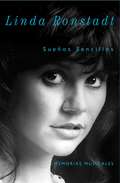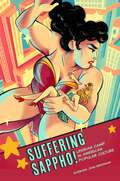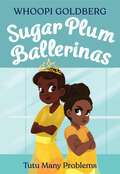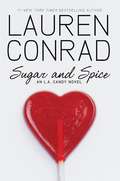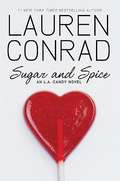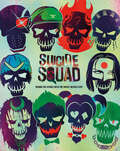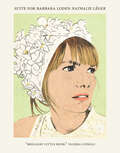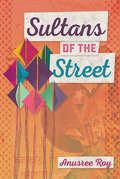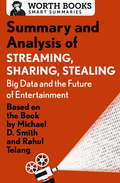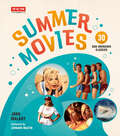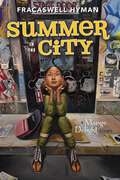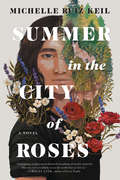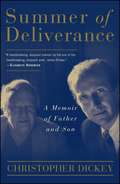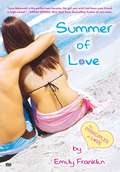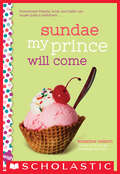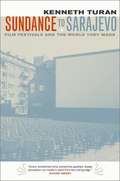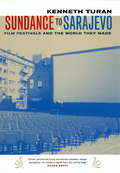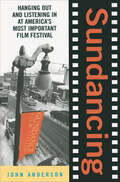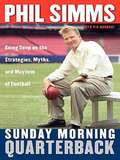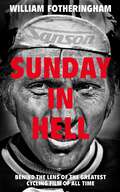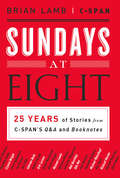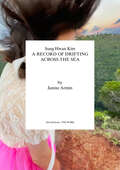- Table View
- List View
Sueños Sencillos: Memorias musicales
by Linda RonstadtAl rastrear la cronología de su extraordinaria vida, Linda Ronstadt, una artista cuya carrera ha abarcado cinco décadas e incluye una amplia gama de estilos musicales, se entreteje una historia cautivante de sus orígenes en Tucson, Arizona, y su ascenso a la fama en la escena musical del sur de California de los años sesenta y setenta. Nacida en una familia de músicos, la infancia de Linda estuvo llena de música que iba desde Gilbert y Sullivan a la música popular mexicana, al jazz y a la ópera. Su curiosidad artística fue precoz, y ella y sus hermanos comenzaron a tocar su música a cualquiera que quisiera escucharlos. Ahora, en este libro de memorias maravillosamente escritas, Ronstadt cuenta la historia de su viaje musical amplio y completamente único. Ronstadt llegó a Los Ángeles cuando el movimiento folk-rock estaba empezando a florecer, preparando así el escenario para el desarrollo del country-rock. Como parte del círculo de artistas afines que tocaron en el famoso club Troubadour en West Hollywood, ella contribuyó a definir el estilo musical que dominó la música mexicana y estadounidense en la década de 1970. Una de sus primeras bandas de respaldo pasó a convertirse en los Eagles, y Linda se volvió en la artista femenina más exitosa de la década. En Sueños Sencillos, Ronstadt revela el viaje ecléctico y fascinante que condujo a su éxito duradero, incluyendo algunas historias detrás de muchas de sus queridas canciones. Y describe todo con una voz tan hermosa como la que cantó "Heart Like a Wheel": de un modo nostálgico, elegante y auténtico.
Sueños Sencillos: Memorias musicales
by Linda RonstadtEn esta memoria, la cantante icónica Linda Ronstadt entreteje una historia cautivante de sus orígenes en Tucson, Arizona, y su ascenso a la fama en la escena musical del sur de California en los años 60 y 70.Al rastrear la cronología de su extraordinaria vida, Linda Ronstadt, una artista cuya carrera ha abarcado cinco décadas e incluye una amplia gama de estilos musicales, se entreteje una historia cautivante de sus orígenes en Tucson, Arizona, y su ascenso a la fama en la escena musical del sur de California de los años sesenta y setenta. Nacida en una familia de músicos, la infancia de Linda estuvo llena de música que iba desde Gilbert y Sullivan a la música popular mexicana, al jazz y a la ópera. Su curiosidad artística fue precoz, y ella y sus hermanos comenzaron a tocar su música a cualquiera que quisiera escucharlos. Ahora, en este libro de memorias maravillosamente escritas, Ronstadt cuenta la historia de su viaje musical amplio y completamente único. Ronstadt llegó a Los Ángeles cuando el movimiento folk-rock estaba empezando a florecer, preparando así el escenario para el desarrollo del country-rock. Como parte del círculo de artistas afines que tocaron en el famoso club Troubadour en West Hollywood, ella contribuyó a definir el estilo musical que dominó la música mexicana y estadounidense en la década de 1970. Una de sus primeras bandas de respaldo pasó a convertirse en los Eagles, y Linda se volvió en la artista femenina más exitosa de la década. En Sueños Sencillos, Ronstadt revela el viaje ecléctico y fascinante que condujo a su éxito duradero, incluyendo algunas historias detrás de muchas de sus queridas canciones. Y describe todo con una voz tan hermosa como la que cantó "Heart Like a Wheel": de un modo nostálgico, elegante y auténtico.
Suffering Sappho!: Lesbian Camp in American Popular Culture
by Barbara Jane BrickmanAn ever-expanding and panicked Wonder Woman lurches through a city skyline begging Steve to stop her. A twisted queen of sorority row crashes her convertible trying to escape her queer shame. A suave butch emcee introduces the sequined and feathered stars of the era’s most celebrated drag revue. For an unsettled and retrenching postwar America, these startling figures betrayed the failure of promised consensus and appeasing conformity. They could also be cruel, painful, and disciplinary jokes. It turns out that an obsession with managing gender and female sexuality after the war would hardly contain them. On the contrary, it spread their campy manifestations throughout mainstream culture. Offering the first major consideration of lesbian camp in American popular culture, Suffering Sappho! traces a larger-than-life lesbian menace across midcentury media forms to propose five prototypical queer icons—the sicko, the monster, the spinster, the Amazon, and the rebel. On the pages of comics and sensational pulp fiction and the dramas of television and drive-in movies, Barbara Jane Brickman discovers evidence not just of campy sexual deviants but of troubling female performers, whose failures could be epic but whose subversive potential could inspire. Supplemental images of interest related to this title: George and Lomas; Connie Minerva; Cat On Hot Tin; and Beulah and Oriole.
Sugar Plum Ballerinas: Tutu Many Problems (Sugar Plum Ballerinas)
by Whoopi Goldberg Deborah UnderwoodThe fourth book of the award-winning and bestselling Sugar Plum Ballerinas series by Whoopi Goldberg—now featuring brand-new illustrations! At the Nutcracker School of Ballet in Harlem, young dancers learn to chassé, plié, and jeté with their Sugar Plum Sisters—but things don't always go to plan! As the girls encounter challenges both on and off stage, they'll need the support of their classmates to carry them through with aplomb. Terrel is always in charge, whether she's making lists for grocery shopping (her favorite hobby, AFTER ballet), keeping her brothers in line, or organizing father-daughter time in with her dad. Lately, though, her dad's been acting a little strange--wearing new clothes and way too much aftershave. Things get even weirder when he surprises Terrel with his new girlfriend during a night out at the ballet - a night that was supposed to be father-daughter time. What's more, his "date" brought her niece along. A niece who turns out to be Terrel's ballerina nemesis, Tiara Girl! With some Sugar Plum help, Terrel takes charge of breaking up her father's new relationship.
Sugar and Spice (L.A. Candy #3)
by Lauren ConradSugar and Spice ... Not everyone's nice. Fresh from being betrayed by one of her closest friends, new reality-television celebrity Jane Roberts has learned a few lessons. Most important: know who to trust. And in Hollywood, that list is short. Although the press is intent on creating a tabloid war between her and ex-friend/current-costar Madison Parker, Jane just wants to take control of her life. She's started by swearing off guys and the drama that comes with them. But when her high school sweetheart Caleb and her unrequited L. A. crush Braden show up, both acting sweeter than ever, Jane has a hard time remembering her no-boys rule. . . . Her best friend, Scarlett, has only one guy on her mind: her new boyfriend, Liam. The girl who once thought love was a four-letter word is now head over heels. The problem is, being on a hit reality show means hanging out with other guys on-camera, and Liam isn't too happy with pretending to play a bit part in her love life. Just when everything feels out of control, Jane makes a shocking discovery--one that changes everyone's definition of "reality" forever. In her deliciously entertaining novel, television star Lauren Conrad pulls back the curtain on young Hollywood and shows that sometimes the real drama is behind the scenes.
Sugar and Spice: An L.A. Candy Novel
by Lauren ConradSugar and Spice . . . Not everyone's nice. Fresh from being betrayed by one of her closest friends, new reality-television celebrity Jane Roberts has learned a few lessons. Most important: know who to trust. And in Hollywood, that list is short. Although the press is intent on creating a tabloid war between her and ex-friend/current-costar Madison Parker, Jane just wants to take control of her life. She's started by swearing off guys and the drama that comes with them. But when her high school sweetheart Caleb and her unrequited L.A. crush Braden show up, both acting sweeter than ever, Jane has a hard time remembering her no-boys rule. . . . Her best friend, Scarlett, has only one guy on her mind: her new boyfriend, Liam. The girl who once thought love was a four-letter word is now head over heels. The problem is, being on a hit reality show means hanging out with other guys on-camera, and Liam isn't too happy with pretending to play a bit part in her love life. Just when everything feels out of control, Jane makes a shocking discovery-one that changes everyone's definition of "reality" forever. In her deliciously entertaining novel, television star Lauren Conrad pulls back the curtain on young Hollywood and shows that sometimes the real drama is behind the scenes.
Suggestopedia and Language
by W. Jane BancroftFirst published in 1999. Routledge is an imprint of Taylor & Francis, an informa company.
Suicide Squad: Behind the Scenes with the Worst Heroes Ever
by Signe BergstromIt feels good to be bad...Assemble a team of the world’s most dangerous, incarcerated super-villains, provide them with the most powerful arsenal at the government’s disposal, and send them off on a mission to defeat an enigmatic, insuperable entity. U.S. intelligence officer Amanda Waller has determined only a secretly convened group of disparate, despicable individuals with next to nothing to lose will do. However, once they realize they weren’t picked to succeed but chosen for their patent culpability when they inevitably fail, will the Suicide Squad resolve to die trying, or decide it’s every man for himself?
Suite for Barbara Loden
by Nathalie LégerThe second in Nathalie Léger&’s acclaimed genre-defying triptych of books about the struggles and obsessions of women artists. &“I believe there is a miracle in Wanda,&” wrote Marguerite Duras of the only film American actress Barbara Loden ever wrote and directed. &“Usually, there is a distance between representation and text, subject and action. Here that distance is completely eradicated.&” It is perhaps this &“miracle&”—the seeming collapse of fiction and fact—that has made Wanda (1970) a cult classic, and a fascination of artists from Isabelle Huppert to Rachel Kushner to Kate Zambreno. For acclaimed French writer Nathalie Léger, the mysteries of Wanda launched an obsessive quest across continents, into archives, and through mining towns of Pennsylvania, all to get closer to the film and its maker. Suite for Barbara Loden is the magnificent result.
Sultans of the Street
by Anusree RoyWhen young orphans Mala and Chun Chun encounter brothers Prakash and Ojha on the busy streets of Kolkata, they are immediately at odds. The brothers come from a lower-middle-class family and spend their time flying kites instead of attending class, while Mala and Chun Chun can only dream of going to school, a goal Aunty promises will be fulfilled if they beg for money from passersby. After a petty fruit-stall heist lands Ojha in Aunty’s cunning hands, the brothers are blackmailed into begging alongside Mala and Chun Chun, forcing the children to interact. Though they find each other nuisances at first, the kids soon realize their strength in numbers as Aunty’s scheming is slowly revealed.
Summary and Analysis of Streaming, Sharing, Stealing: Big Data and the Future of Entertainment
by Worth BooksSo much to read, so little time? This brief overview of Streaming, Sharing, Stealing tells you what you need to know—before or after you read Michael D. Smith’s and Rahul Telang’s book. Crafted and edited with care, Worth Books set the standard for quality and give you the tools you need to be a well-informed reader. This short summary and analysis of Michael D. Smith and Rahul Telang’s Streaming, Sharing, Stealing includes: Historical context, Chapter-by-chapter summaries, Character profiles, Important quotes, Fascinating trivia, Glossary of terms, Supporting material to enhance your understanding of the original work. About Streaming, Sharing, Stealing by Michael D. Smith and Rahul Telang: There is a new world order in the entertainment industry. Digital technology has contributed to an explosion of content in the entertainment business as Netflix, Amazon, and Apple upend traditional entertainment, changing the way in which television, film, music, and books are made and consumed. In Streaming, Sharing, Stealing: Big Data and the Future of Entertainment, authors Smith and Telang document this massive change and demonstrate conclusively that making data-driven decisions and understanding customer behavior are the keys to the new marketplace. The summary and analysis in this ebook are intended to complement your reading experience and bring you closer to a great work of nonfiction.
Summer Movies: 30 Sun-Drenched Classics (Turner Classic Movies)
by Turner Classic Movies John MalahyTurner Classic Movies presents a festival of sunshine classics—movies that capture the spirit of the most carefree season of the year—complete with behind-the-scenes stories, reviews, vacation inspiration, and a trove of photos.Summer Movies is your guide to 30 sun-drenched classics that—through beach parties, road trips, outdoor sports, summer camp, or some intangible mood that brings the heat—manage to keep summer alive year-round. Packed with production details, stories from the set, and more than 150 color and black-and-white photos, the book takes an in-depth look at films from the silent era to the present that reflect the full range of how summer has been depicted on screen, both by Hollywood and by international filmmakers. Featured titles include Moon Over Miami (1941), State Fair (1945), Key Largo (1948), Monsieur Hulot's Holiday (1953), The Seven Year Itch (1955), The Parent Trap (1961), The Endless Summer (1964), Jaws (1975), Caddyshack (1980), Dirty Dancing (1987), Do the Right Thing (1989), Moonrise Kingdom (2012), Call Me by Your Name (2017), and many more.
Summer in the City (Mango Delight #2)
by Fracaswell HymanGet ready, world—Mango&’s about to become a STAR! In this sequel to Mango Delight, the delightful heroine&’s adventures—and misadventures—continue as she prepares to make her off-Broadway debut. Where Mango goes, drama is sure to follow! It&’s summer break, and Mango is content to spend her time babysitting her brother, hanging with her friend Izzy, and binge-watching movies late into the night. Then she runs into her drama teacher, who has some big news: their middle school play Yo, Romeo! is headed to the stage in New York City . . . and he wants Mango for the lead role! After overcoming her mom&’s initial reluctance—and with some firm rules established—Mango goes off to Brooklyn to stay with her Aunt Zendaya in a teeny apartment and prepare for her theatrical debut. It&’s the opportunity of a lifetime, but soon Mango must confront homesickness, insecurity, and the all-important question of what it means to be a good friend—especially when you&’re far away from the people you love.
Summer in the City of Roses
by Michelle Ruiz KeilInspired by the Greek myth of Iphigenia and the Grimm fairy tale "Brother and Sister," Michelle Ruiz Keil's second novel follows two siblings torn apart and struggling to find each other in early '90s Portland. All her life, seventeen-year-old Iph has protected her sensitive younger brother, Orr. But this summer, with their mother gone at an artist residency, their father decides it&’s time for fifteen-year-old Orr to toughen up at a wilderness boot camp. When their father brings Iph to a work gala in downtown Portland and breaks the news, Orr has already been sent away against his will. Furious at her father&’s betrayal, Iph storms off and gets lost in the maze of Old Town. Enter George, a queer Robin Hood who swoops in on a bicycle, bow and arrow at the ready, offering Iph a place to hide out while she tracks down Orr. Orr, in the meantime, has escaped the camp and fallen in with The Furies, an all-girl punk band, and moves into the coat closet of their ramshackle pink house. In their first summer apart, Iph and Orr must learn to navigate their respective new spaces of music, romance, and sex-work activism—and find each other before a fantastical transformation fractures their family forever. Told through a lens of magical realism and steeped in myth, Summer in the City of Roses is a dazzling tale about the pain and beauty of growing up.
Summer of Deliverance: A Memoir of Father and Son
by Christopher DickeySummer of Deliveranceis a powerful and moving memoir of anger, love, and reconciliation between a son and his father. Hailed as a literary genius of his generation, James Dickey created his art and lived his life with a ferocious passion. He was a heavy drinker, a destructive husband and father, a poet of grace and sensitivity, and, after the publication and subsequent film of his novel,Deliverance,a wildly popular literary star. Drawing on letters, notebooks, diaries, and his explicit conversations with his father, Christopher Dickey has crafted a superb memoir of the corrosive effects of fame, a moving remembrance of a crisis that united a family, and an inspiring celebration of love between father and son.
Summer of Love: The Principles of Love
by Emily FranklinAfter a rough spring semester at Hadley Hall, Love Bukowski is ready for some sun on Martha's Vineyard. Running her Aunt Mable's cafe might not sound glamorous, but when she's working with her best friend, Arabella, anything can be fun. Plus, Mable's set up a treasure map of clues for her to find--each one bringing Love closer to the truth about her family history. But now that those pieces of her past are finally fitting together, Love's future isn't clear. College and senior year are ahead, but the boys of summer are more appealing than ever. Surprises, sun, summer love--no matter what happens, the next three months will be ones to write home about.
Sundae My Prince Will Come: A Wish Novel (Fountas & Pinnell LLI Blue)
by Suzanne NelsonA foodtastic tween romance with ice cream, ballet, friends, and happily-ever-after from the author of Cake Pop Crush and You’re Bacon Me Crazy.Malie’s mom manages an ice cream parlor, but Malie’s real love is ballet. She dreams of landing the lead in an upcoming production of Cinderella and dancing onstage while her boyfriend, Ethan, cheers from the audience. But Malie’s mom is less than supportive.Then cute new boy Alonzo arrives from Italy. His true love is ice cream—gelato, to be exact. Alonzo offers a Malie a deal: If she lets him help out at the parlor, she can take dance lessons from his mom, a famed ballerina.As Malie pirouettes between the parlor and the ballet studio, things start to spin out of control. Does she have feelings for Alonzo? What about Ethan? And if she doesn’t get a role in Cinderella, can she find her happily ever after?
Sundance to Sarajevo: Film Festivals and the World They Made
by Kenneth TuranA journalistic account of all the superficial glitz that we associate with film festivals, along with an account of the serious business that goes on there, and of the politics behind the glamor. There have been books about individual festivals, but never anything as comprehensive as this.
Sundance to Sarajevo: Film Festivals and the World They Made
by Kenneth TuranAlmost every day of the year a film festival takes place somewhere in the world--from sub-Saharan Africa to the Land of the Midnight Sun. Sundance to Sarajevo is a tour of the world's film festivals by an insider whose familiarity with the personalities, places, and culture surrounding the cinema makes him uniquely suited to his role. Kenneth Turan, film critic for the Los Angeles Times, writes about the most unusual as well as the most important film festivals, and the cities in which they occur, with an eye toward the larger picture. His lively narrative emphasizes the cultural, political, and sociological aspects of each event as well as the human stories that influence the various and telling ways the film world and the real world intersect. Of the festivals profiled in detail, Cannes and Sundance are obvious choices as the biggest, brashest, and most influential of the bunch. The others were selected for their ability to open a window onto a wider, more diverse world and cinema's place in it. Sometimes, as with Sarajevo and Havana, film is a vehicle for understanding the international political community's most vexing dilemmas. Sometimes, as with Burkina Faso's FESPACO and Pordenone's Giornate del Cinema Muto, it's a chance to examine the very nature of the cinematic experience. But always the stories in this book show us that film means more and touches deeper chords than anyone might have expected. No other book explores so many different festivals in such detail or provides a context beyond the merely cinematic.
Sundancing: Hanging Out and Listening In at America's Most Important Film Festival
by John AndersonEvery winter, 8,000 feet above sea level in the Utah snow, the hopes and dreams of young moviemakers are put on display at the Sundance Film Festival--the haven for independent films where you can show up a kid and go home a star. In barely twenty years of existence, the festival--now overseen by Robert Redford's Sundance Institute--has assumed tremendous importance for today's film culture: during the annual ten-day event, tiny Park City is so overrun by agents, publicists, studio executives, and other Hollywood types that in 1988 they blew out the town's cell-phone relay system.
Sunday Morning Quarterback: Going Deep on the Strategies, Myths, and Mayhem of Football
by Phil Simms Vic CarucciSimms, a former New York Giants quarterback and CBS sports annalist, provides a behind the scenes look at football and the NFL. Includes many anecdotes from Simms' own career.
Sunday Nights at Seven: The Jack Benny Story
by Jack Benny Joan Benny" What was it like growing up with such a famous comedian for a father? Did he make time for her . . . share her interests? What was the relationship she saw between her parents? Was life in the Benny household all a barrel of laughs? What was Jack like out of the public eye, when he let his hair down? (That's where Jack and I were different. He would let his hair down, I just took mine off.) The point is, Joan Benny was there. She had a front row seat. And most of all, the great pleasure of this book is that so much of it is in Jack's own voice. So the pages that follow should make for interesting reading. I miss Jack. He was a nice man." --George Burns Other books about Jack Benny are available from Bookshare.
Sundays at Eight: 25 Years of Stories from C-SPAN'S Q&A and Booknotes
by Brian Lamb C-SpanFor the last 25 years, Sunday nights at 8pm on C-SPAN has been appointment television for many Americans. During that time, host Brian Lamb has invited people to his Capitol Hill studio for hour-long conversations about contemporary society and history. In today's soundbite culture that hour remains one of television's last vestiges of in-depth, civil conversation.First came C-SPAN's Booknotes in 1989, which by the time it ended in December 2004, was the longest-running author-interview program in American broadcast history. Many of the most notable nonfiction authors of its era were featured over the course of 800 episodes, and the conversations became a defining hour for the network and for nonfiction writers.In January 2005, C-SPAN embarked on a new chapter with the launch of Q and A. Again one hour of uninterrupted conversation but the focus was expanded to include documentary film makers, entrepreneurs, social workers, political leaders and just about anyone with a story to tell.To mark this anniversary Lamb and his team at C-SPAN have assembled Sundays at Eight, a collection of the best unpublished interviews and stories from the last 25 years. Featured in this collection are historians like David McCullough, Ron Chernow and Robert Caro, reporters including April Witt, John Burns and Michael Weisskopf, and numerous others, including Christopher Hitchens, Brit Hume and Kenneth Feinberg.In a March 2001 Booknotes interview 60 Minutes creator Don Hewitt described the show's success this way: "All you have to do is tell me a story." This collection attests to the success of that principle, which has guided Lamb for decades. And his guests have not disappointed, from the dramatic escape of a lifelong resident of a North Korean prison camp, to the heavy price paid by one successful West Virginia businessman when he won $314 million in the lottery, or the heroic stories of recovery from the most horrific injuries in modern-day warfare. Told in the series' signature conversational manner, these stories come to life again on the page. Sundays at Eight is not merely a token for fans of C-SPAN's interview programs, but a collection of significant stories that have helped us understand the world for a quarter-century.
Sung Hwan Kim: A Record of Drifting Across the Sea (Afterall Books / One Work)
by Janine ArminA richly illustrated exploration of Sung Hwan Kim&’s complex record of migrant stories, displacement and belonging, border-crossings and translation.In A Record of Drifting Across the Sea (2017–), Sung Hwan Kim turns to past histories of migration. The artist parses the traces—archival and bodily—left by undocumented Korean migrants who came to the US by way of Hawai&’i at the turn of the last century, and ponders over their impact on other migrant and indigenous communities. As an ongoing film and installation series, comprising two chapters and a third in progress, A Record unsettles the limits of the "one work" with its distributive, open-ended and collaborative nature. In this speculative inquiry, Janine Armin explores each chapter in Kim&’s multilayered work as a mycelial network of feelers entangling and extending the wider work in process. Engaging history through the senses, folklore and myth, as much as through archival material, Kim navigates and crosses the boundaries between displacement and belonging. Focusing on the artist&’s attempt to escape from representation, Armin illuminates and attends to the different stories and non-sovereign ways of being together towards which his work points us. This title is part of the One Work book series, which focuses on artworks that have significantly changed the way we understand art and its history.
